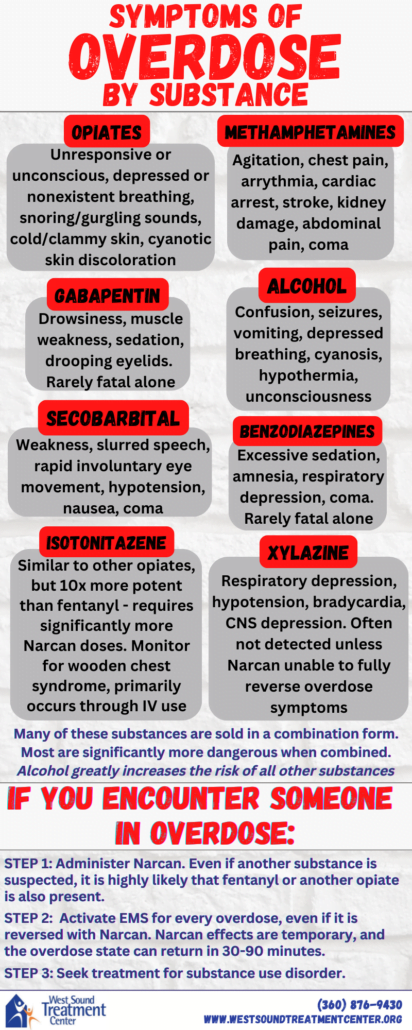
Infographic Text Below
Symptoms of Overdose by Substance
- Opiates: Unresponsive or unconscious, depressed or nonexistent breathing, snoring/gurgling sounds, cold/clammy skin, cyanotic skin discoloration
- Methamphetamines: Agitation, chest pain, arrythmia, cardiac arrest, stroke, kidney damage, abdominal pain, coma
- Gabapentin: Drowsiness, muscle weakness, sedation, drooping eyelids. Rarely fatal alone
- Alcohol: Confusion, seizures, vomiting, depressed breathing, cyanosis, hypothermia, unconsciousness
- Secobarbital: Weakness, slurred speech, rapid involuntary eye movement, hypotension, nausea, coma
- Benzodiazepines: Excessive sedation, amnesia, respiratory depression, coma. Rarely fatal alone
- Isotonitazene: Similar to other opiates, but 10x more potent than fentanyl – requires significantly more Narcan doses. Monitor for wooden chest syndrome, primarily occurs through IV use
- Xylazine: Respiratory depression, hypotension, bradycardia, CNS depression. Often not detected unless Narcan unable to fully reverse overdose symptoms
Many of these substances are sold in a combination form. Most are significantly more dangerous when combined. Alcohol greatly increases the risk of all other substances.
If You Encounter Someone in Overdose:
- STEP 1: Administer Narcan. Even if another substance is suspected, it is highly likely that fentanyl or another opiate is also present.
- STEP 2: Activate EMS for every overdose, even if it is reversed with Narcan. Narcan effects are temporary, and the overdose state can return in 30-90 minutes.
- STEP 3: Seek treatment for substance use disorder.



